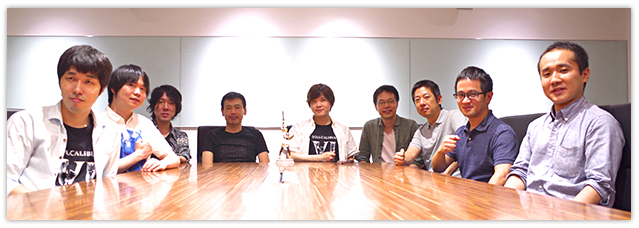We will share behind-the-scene stories on the development of ‘SOULCALIBUR VI’, the weapon-based fighting game for Playstation®4 (*1) / Xbox One (*2) / STEAM® (*3).
In this article, we will share passionate stories from our Developers regarding the making of ‘SOULCALIBUR VI’, which was developed with the concept “Reboot”, to mark the 20th anniversary of the series.
Project Members of ‘SOULCALIBUR VI’ development
| Michinori Ozawa | Game Designer / Producer SOULCALIBUR devotee who has produced a number of titles. |
|---|---|
| Yoshinori Takahashi | Game Designer / Director A living SOULCALIBUR VI dictionary. The team gave him the nickname “Masuteru”. |
| Tomofumi Osaka | Game Designer / Battle Director The world’s best ‘SOULCALIBUR VI’ live commentator. |
| Masanori Ota | Program Engineer / Lead Programmer Quick to action, super-programmer. |
| Hideo Yoshie | Visual Designer / Art Director Artist who has worked on the SOULCALIBUR series from the very beginning. |
| Junichi Nakatsuru | Sound Creator / Sound Director A master in the world of game sound. |
| Kazuo Takahashi | Game Designer / DLC Development Producer. The man who will lead the development team of SOULCALIBUR, “Project Soul”, from hereon. |
| Hiromichi Iijima | Animator / DLC Animation Director New star in the fighting-game genre. |
| Yoshihito Yano | Sound Creator / DLC Sound Director The man who makes everyone happy! |
Many challenges even before starting development!
■Ozawa: Thanks to everyone for gathering today. In ‘Part 1’, I’d like to focus our conversation on what we challenged ourselves on during the development of SOULCALIBUR VI.
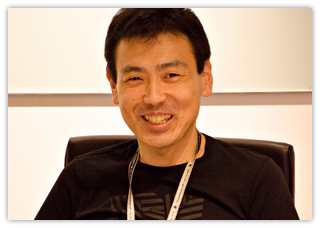
●Michinori Ozawa
Game Designer / Producer
●Ozawa: Firstly, let me share what went on before starting development. Though I’ve worked on 20 titles as a Producer, ‘SOULCALIBUR VI’ was the most difficult one to start up. There were two major difficulties. The first one was the large scale of the game. The second one was a shortage of Developers.
For the former, I presented the project pitch in a meeting room full of board members and managers about six years ago. I told them, “I want to make ‘SOULCALIBUR VI’! ” and explained my plan. Everyone crossed their arms, frowning, and pointed out problems like “There are too many modes!”, “How can you create this title with such a small number of Developers?” As the board members and managers of BANDAI NAMCO Studios are also experienced Developers, they can immediately calculate the necessary time and money for development. Therefore, there is no way anyone could pull a fast one on them.
Other than that, they asked me “Is the character creation mode really necessary?” or “This is a fighting game. Why do you need to create ‘stand-alone’ mode?” etc. I said to them “Wait a second, in SOULCALIBUR, we shouldn’t forget about fans who play with ‘stand-alone mode’!” Then they asked, “If the main focus of the game is ‘stand-alone’ mode, ‘online-mode’ isn’t necessary, right?”
So, I explained to them in detail. Over the 20-year history of SOULCALIBUR, what we held important, and how we can utilize that to entertain the world. Putting the series’ philosophy into words and persuading senior employees was not an easy task.
Moving on to the second problem. The development team (=Project Soul) was dissolved after completing ‘SOULCALIBUR V’. In particular, we had a hard time finding Developers capable of making battles. So about five years ago, Mr. Takahashi and I went to the SOULCALIBUR event in Heiwajima in hopes of somehow finding Developers like that there. Every time we came across an expert player there, we tapped him/her on the shoulder and asked, “Excuse us, but would you be interested in creating SOULCALIBUR with us?”
●Yano: That really sounds like a TV drama…!
●Nakatsuru: By the way, is being a good player of the game directly related to being a good game creator?
●Takahashi (Yoshinori): No, not always. In development, a Developer should also be a team player, right? We mainly approached people who seemed like they would be able to work in a team.
●Nakatsuru: It must have been so difficult to choose!
●Ozawa: Yes, and finding a good time to approach them was also difficult. They were so surprised, going “What!?”, when they were suddenly talked to at the event. It’s only natural, I suppose. Moreover, we often brought the player to a corner to talk more. We must have looked so suspicious there.
●Osaka: You took them to the corner of the food court, didn’t you?
●Ozawa: Yeah! That’s right.
●All: Seriously? (Laughter)
●Ozawa: To build a team which can create a “Reboot” (Meaning a “restructuring”, not “rehash”) product, we desperately needed young talents. Those enthusiastic players already have a deep understanding of the SOULCALIBUR world, though they were inexperienced in game development. All I had to do was to prepare a workplace for them, taking that risk upon myself, regardless of what the company would say. In addition to the veterans, who are now core members, I think we must never forget to bring in a new gust of wind (new staff) now and then to invigorate things.
Challenging tasks for engineers
■Ozawa: Well, now I’d like to ask a programmer a question. Mr. Ota, what challenges did you face in the development of ‘SOULCALIBUR VI’?
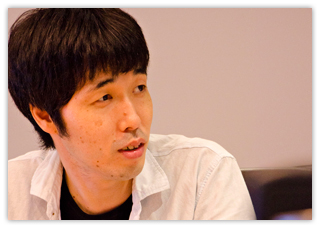
●Ota Masanori
Program Engineer/ Lead Programmer
●Ota: ‘SOULCALIBUR V’ was developed for PlayStation®3 and Xbox 360®. But ‘SOULCALIBUR VI’ had to run on new hardware – PlayStation®4, Xbox One and Personal Computers – hardware that we had never developed for before. In such cases, we usually do lots of research before starting. However, thanks to Unreal® Engine (*4), which we adopted for this title, it did not take long for us to get the visuals out.
As for game mechanics, if we had developed everything on Unreal® Engine, we might have lost the rich atmosphere of SOULCALIBUR born from 20-years of history. We struggled with how to migrate resources accumulated over 20-years of SOULCALIBUR history… For example, we had to throw ourselves at the challenge of figuring out how to reuse animations, battle scripts, and other complicated things, to create vivid battle scenes in Unreal® Engine.
*4:Unreal® Engine
Game engine developed by Epic Games, Inc.
■Ozawa: Masuteru-san (Mr.Takahashi), when experienced players played ‘SOULCALIBUR VI’ for the first time at EVO Japan (*5), how did you feel?
*5:EVO Japan
Evolution Championship Series(hereinafter referred to as “EVO”)is one of the largest fighting-game tournaments in the world, with a long history. Highly skilled players from all over the world gather in Las Vegas to test their polished skills against each other, while abiding to strict rules of sportsmanship and fair play. EVO Japan is another major tournament that shares EVO’s philosophies.
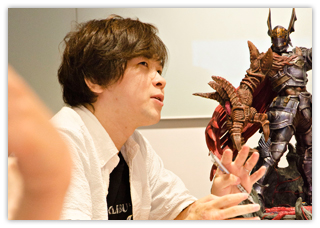
●Yoshinori Takahashi
Game Designer / Director
●Takahashi (Yoshinori): The ‘SOUL’ series has 20 years of history. From the first version ‘SOUL EDGE’ to the latest one ‘SOULCALIBUR VI’, every title has a different operational feeling. So, it’s very difficult to find out what kind of feeling is required every time. This time, I told Mr. Ota “I would like to pick up and combine good points from different versions like– the responsive feeling from ‘SOULCALIBUR II’, and the well-balanced feeling from ‘SOULCALIBUR V’.
●Ota: Yeah, that was where we started.
■Ozawa: Mr. Ota, what did you think when you heard that request from Mr. Takahashi (Yoshinori)?
●Ota: Well, I just laughed.
■Ozawa: Do you mean that it was “A piece of cake?”
●Ota: Oh, no. Of course not.
●Takahashi (Yoshinori): Actually, Mr. Ota himself is a dedicated “fighting-game player”. That led to a breakthrough. There are programmers who tend to only think about the technical aspects, but Mr. Ota went about it with the passion of a die-hard player. I believe that we managed to get good results thanks to having Mr. Ota in the Battle Team.
■Ozawa: Mr. Ota, the Director, Mr. Takahashi, just gave you a stellar appraisal. How do you feel?
●Ota: Well, programmers spends most of their time on programming, but I spend time on playing various fighting-games, too. That helped me to come to realizations such as, “Ah, the Battle Team wants me to make that,” instantly, and I think that really helped to increase efficiency. In that sense, regarding my involvement on this series, I guess it was rather easy for me to work on; or easy for me to make. I have been playing fighting games for more than 20 years, since I was in elementary school, and I just love the genre, but I had never imagined that I’d work on fighting games as a programmer. Now I feel lucky because I can make use of my experience as a player on developing this game.
In our company, when fighting game development teams come across good players, we tend to try to recruit him/her. Interesting company, don’t you think? (Laughs)
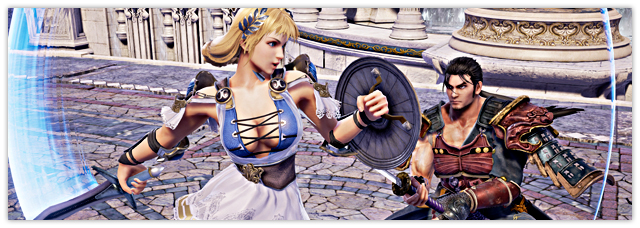
©BANDAI NAMCO Entertainment Inc.
Challenges in making exciting battles
■Ozawa: Mr. Osaka, could you tell us what challenges you encountered in the development of this title?
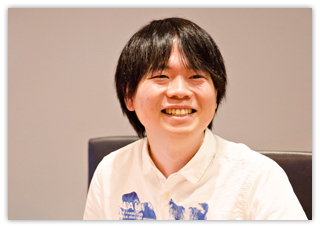
●Tomofumi Osaka
Game Designer/Battle Director
●Osaka: When we adopted a new battle system this time, we first tried to link actual battles and the visual presentation, with consideration as to how to make tournaments more exciting.
In cartoons or movies, we often see scenes where, when a swordsman is fighting for his life, at critical moments, it looks as if time has stopped, right? We talked about how it would be interesting if we could have that sort of effect in fighting games, and how when that occurs, players would be able to dish out lots of damage to opponents. It is visually stunning; and at that moment, we switch to a special camera, and your character looks super cool.
Then, someone in the audience might think, “I don’t know much about SOULCALIBUR because I’ve never played it before, but this player must be an expert because the way he/she beat that opponent just now was so cool!”, causing the atmosphere in the event to heat up. Linking up the battle system and the visuals in this way was my challenge this time (The Reversal Edge, the Lethal Hit).
■Ozawa: Do you mean that you made it in such a way in order to make live commentaries more exciting too?
●Osaka: That’s right. I have been doing live commentaries for a while. I know when I should speak loudly, how the audience will react or when they will applaud, and so on. I designed the battle system will all that in mind.
■Ozawa: It’s important for games to be easily live-streamed.
●Osaka: Yes, it’s really important!
Sound effects reflecting characters’ rich background
■Ozawa: How about the Sound Team? What challenges did you face?
●Yano: For sound effects, in special scene, like the Reversal Edge, we added a special sound effect to change the atmosphere.
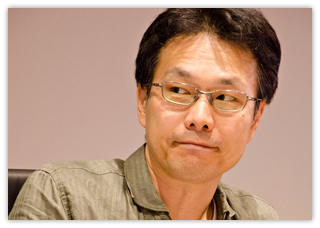
●Junichi Nakatsuru
Sound Creator / Sound Director
●Nakatsuru: When I first saw the prototype of the Reversal Edge, its visual effects looked nothing like anything ever seen in previous SOULCALIBUR titles. Mr. Yano and I have worked on this series for long time, on the Sound Team. So far, we focused a lot on battle tempo. Now all of a sudden, with this slow-motion effect, it looks as if the flow of time has been changed just for that effect.
It took some time to get used to it, but after that, I realized just how effective special visual effects like are in terms of stirring up emotions, whether in commentaries or battles. Then I realized that we also needed to add unique sound effects for that visually unique scene to express the change in how time flows
■Ozawa: What changes did you make?
●Nakatsuru: For the Reversal Edge scene, when activated, instead of stopping the music, we decided to make some changes to the ongoing music. For example, in some stages, we reduced it to rhythmic instruments only, or even by adding in new sounds, in order to make things more exciting.
■Ozawa: You mean to say, you strove to recreate the tense atmosphere of an intense battle between master swordsmen.
●Nakatsuru: Yes. Adding sounds is a very effective method, but not always. In some cases, subtracting some sounds and leaving only necessary sounds behind can be more effective. We had to judge which method was most suitable for each individual situation.
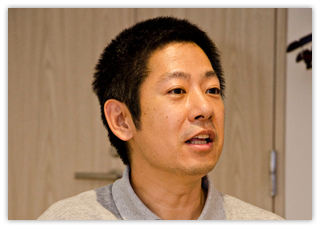
●Yoshihito Yano
Sound Creator / DLC Sound Director
●Yano: Depending on the situation, sound effects can be very important. In such cases, I would lower the BGM volume in order to emphasize sound effects. Furthermore, if very thrilling BGM is played from the beginning to the end of a battle, the battle can be end up feeling monotone or flat. We have to add sound effects appropriate to each scene. For example, when two characters in a battle step away from each other, the tempo of the music becomes slower, to express the cooling down of tension in the scene. We had a lot of trial and error when it came to making sound effects that would change in line with the state of the battle.
●Nakatsuru: In Reversal Edge scenes, we would often play some impressive dialogue. If the BGM is too loud, those lines will be lost. However, when other sounds are quiet, those lines will sound really dramatic and effective. I believe this resulted in a really good system where players can get a glimpse into the characters’ state of mind during battles.
●Takahashi(Yoshinori): Yeah, it makes it easier for players to find out more about characters. For example, “Ah, these two characters are rivals!” The Sound Team had a perfect understanding of what we were aiming for with our specifications, and I am truly grateful for their help. We were able to make a much better game thanks to them.
●Yano: If a player becomes interested in a characters’ background through a battle, and thus decides to play the game’s in Story Mode, that’s exactly what we aimed for. Connecting battles to the story was one of our goals as a Sound Team. I am truly happy that our sound effects contributed to making this a more dramatic game. Dramatic effects are really moving, aren’t they. Being able to ‘feel’ the story while going through battles. It is really rewarding for us when, through sound effects, we can help players to understand how characters are feeling, or why that character is fighting.
●Nakatsuru: Usually, it’s hard to balance between the battle system and the Story Mode (Laughs). Finding a good balance is a difficult task for Developers, however if the game fully focuses on battles, we won’t be able to satisfy players who are interested in the Stories, and players who are only interested in Battles won’t care much about Story Mode. In that sense, I believe we have managed to do an exceptional job on this game.
●Yano: I often found myself thinking of the difficult destiny some of the characters had, and often found myself holding back tears while working on some characters like Amy…
Official website
https://sc6.soularchive.jp/
Distributer: BANDAI NAMCO Entertainment
*All company names and product names are trademarks or registered trademarks of their respective companies.
(*1)”PlayStation” is the trademark or a registered trademark of Sony Interactive Entertainment Inc.
(*2)”Xbox One” is the trademark or a registered trademark of Microsoft Corporation in the United States of America and/or related companies.
(*3)”©2019 Valve Corporation. Steam” and the logo of “Steam” are trademarks or registered trademarks of Valve Corporation in the United States of America and elsewhere.
(*4)Unreal® is a trademark or registered trademark of Epic Games, Inc. in the United States of America and elsewhere. Unreal® Engine, Copyright 1998 – 2019, Epic Games, Inc. All rights reserved.
「SOULCALIBUR VI」
SOULCALIBUR™ VI & ©BANDAI NAMCO Entertainment Inc.



